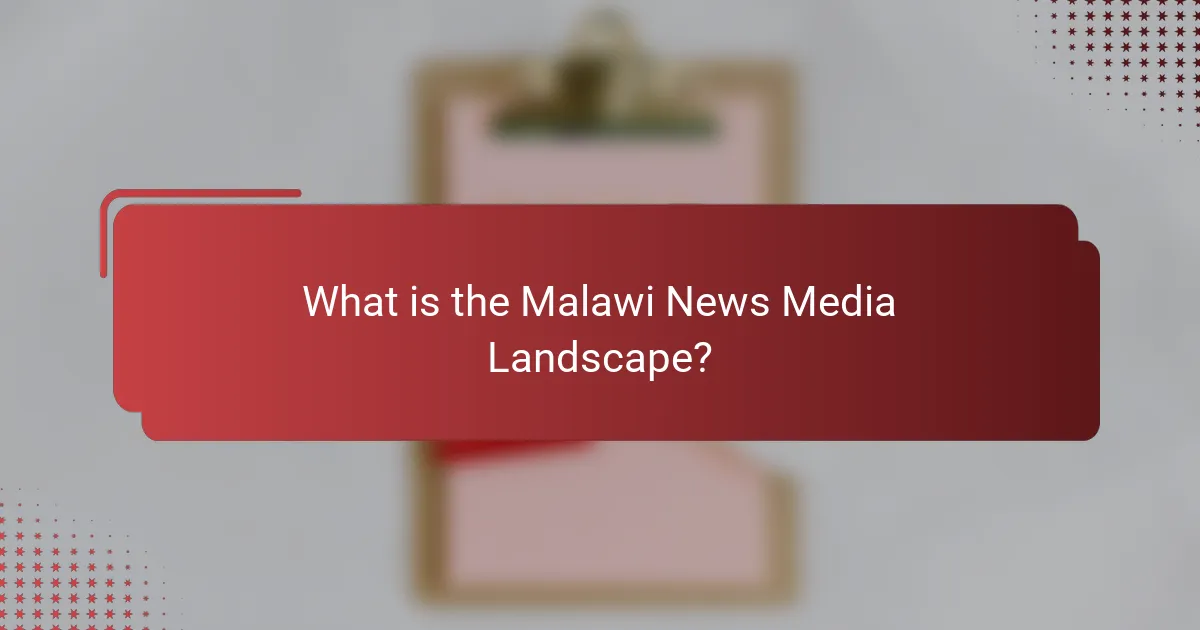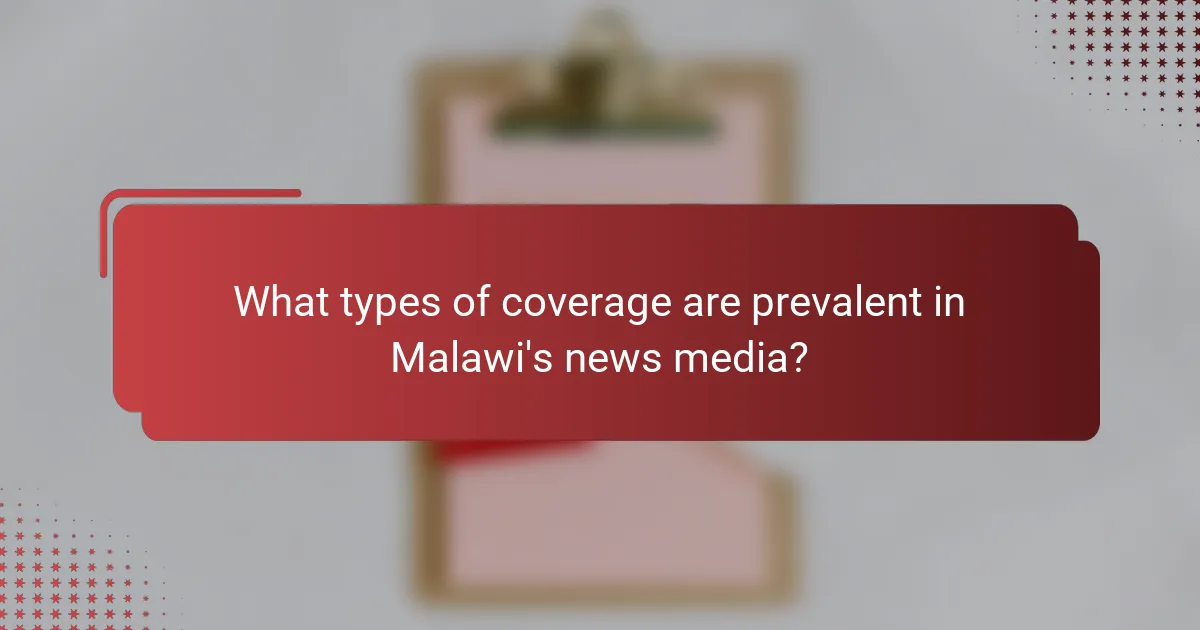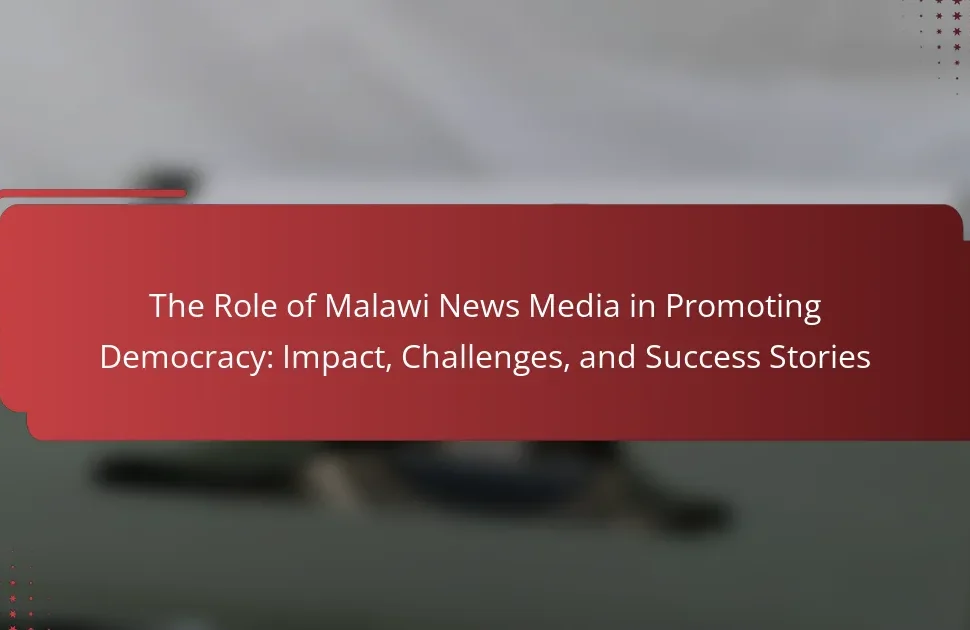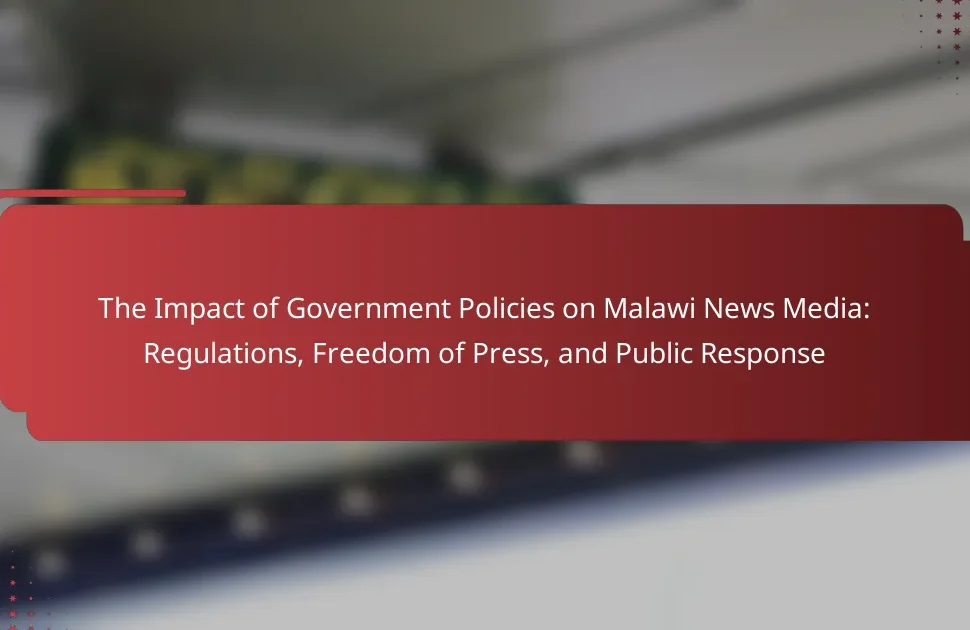The article examines the Malawi news media landscape, highlighting key platforms such as print, radio, and online media. Prominent traditional newspapers include The Daily Times and The Nation, while radio, led by Malawi Broadcasting Corporation, remains the most widely consumed medium. The rise of online news platforms like Nyasa Times and Malawi24 reflects changing consumption habits, particularly in urban areas with greater digital access. Coverage primarily focuses on politics, social issues, and health, addressing significant topics relevant to Malawi’s socio-political context. The audience reach is approximately 10 million people, with radio being the most accessible medium for the majority of households.

What is the Malawi News Media Landscape?
The Malawi news media landscape consists of various platforms including print, radio, and online media. Traditional newspapers such as The Daily Times and The Nation are prominent in print. Radio remains the most widely consumed medium, with stations like Malawi Broadcasting Corporation leading in reach. Online news platforms have gained traction, with websites like Nyasa Times and Malawi24 providing news coverage. The country has a diverse audience, with urban areas having higher access to digital news. Government regulations and press freedom issues influence media operations. Overall, the landscape reflects a mix of traditional and modern media, catering to different segments of the population.
How has the Malawi news media evolved over time?
The Malawi news media has evolved significantly since the 1990s. Initially, it was dominated by state-owned outlets under a one-party system. The introduction of multiparty democracy in 1994 led to a surge in private media establishments. This shift increased diversity in news coverage and opinion. The growth of radio stations and newspapers has been notable. By 2020, over 30 radio stations and numerous print media were operational. Digital media has also gained traction, particularly with mobile phone usage. Social media platforms have become vital for news dissemination. The evolution reflects broader societal changes and increased public demand for information.
What historical events have shaped the current media landscape?
The current media landscape in Malawi has been shaped by several historical events. The introduction of multiparty democracy in 1993 allowed for greater media freedom. This shift led to the emergence of private media outlets. Prior to this, the media was largely state-controlled. The 1994 general elections marked a significant turning point for media diversity. The establishment of the Malawi Communications Regulatory Authority in 2000 further enhanced media regulation. Additionally, the rise of digital technology has transformed media consumption patterns. These events collectively contributed to a more vibrant and pluralistic media environment in Malawi.
What are the key milestones in Malawi’s media development?
Malawi’s media development has undergone several key milestones. The establishment of the first newspaper, the “Nyasaland Times,” in 1895 marked the beginning of print media. In 1993, Malawi transitioned to a multi-party democracy, leading to increased media freedom. The Malawi Communications Regulatory Authority (MACRA) was formed in 1998 to oversee broadcasting and telecommunications. The introduction of community radio stations in the early 2000s expanded access to information. In 2010, the Access to Information Bill was passed, promoting transparency. The rise of digital media and social platforms has further transformed the media landscape in recent years. These milestones collectively illustrate the evolution of media in Malawi.
Who are the key players in the Malawi news media?
The key players in the Malawi news media include major newspapers, radio stations, and television networks. Prominent newspapers are The Nation and Malawi News. Major radio stations include Zodiak Broadcasting Station and Malawi Broadcasting Corporation. Key television networks are Malawi Broadcasting Corporation TV and Times TV. These entities significantly influence public opinion and provide news coverage across various platforms. Their reach encompasses urban and rural audiences, contributing to the overall media landscape in Malawi.
What roles do public and private media outlets play?
Public media outlets in Malawi serve to inform the public, promote national culture, and provide educational content. They are funded by the government and aim to reflect diverse viewpoints. Private media outlets focus on commercial interests and often prioritize profit-driven content. They provide a platform for independent voices and can cover topics that may not be addressed by public outlets. Both types of media contribute to a balanced media landscape by offering varied perspectives and fostering public discourse. Public media often emphasizes accountability and public service, while private media can drive competition and innovation in content delivery.
How do international media influence Malawi’s news landscape?
International media significantly influence Malawi’s news landscape by shaping public perception and providing diverse information sources. They offer coverage on critical issues such as governance, human rights, and economic development. This coverage often highlights stories that local media may overlook or underreport. For instance, international outlets like BBC and Al Jazeera bring attention to Malawi’s political events and social challenges. Their reporting can lead to increased awareness and pressure on local authorities. Additionally, international media can impact local journalism standards and practices. They often set benchmarks for investigative reporting and ethical journalism. This influence encourages local media to improve their reporting quality and accountability. Overall, international media play a crucial role in informing Malawians and influencing the national discourse.

What types of coverage are prevalent in Malawi’s news media?
Malawi’s news media predominantly covers politics, social issues, and health. Political coverage includes government activities, elections, and party dynamics. Social issues focus on human rights, education, and community development. Health coverage addresses public health crises, diseases, and healthcare access. These topics are significant due to Malawi’s socio-political context and ongoing development challenges. News outlets like Malawi24 and The Nation frequently report on these themes, reflecting public interest and engagement.
What are the primary categories of news coverage?
The primary categories of news coverage are hard news, soft news, investigative journalism, and feature stories. Hard news focuses on timely events and facts, such as politics and emergencies. Soft news covers lifestyle, entertainment, and human interest stories, appealing to emotions. Investigative journalism involves in-depth research to uncover hidden information or corruption. Feature stories provide a detailed look at a topic, often with a narrative style. Each category serves distinct purposes in informing and engaging the audience.
How does political coverage differ from social coverage?
Political coverage focuses on government actions, policies, and political events. It often includes analysis of political parties and elections. This type of coverage is aimed at informing the public about governance and civic responsibilities. Social coverage, on the other hand, centers on societal issues, cultural events, and community stories. It emphasizes human interest and social dynamics rather than political processes.
In Malawi, political coverage often features reports on legislative activities and political debates. Social coverage includes stories about local festivals, health initiatives, and educational developments. The audience for political coverage typically seeks information to engage in civic activities. In contrast, the audience for social coverage is often interested in community welfare and cultural identity.
What role does investigative journalism play in Malawi?
Investigative journalism in Malawi plays a crucial role in promoting transparency and accountability. It uncovers corruption, human rights abuses, and government malpractice. This form of journalism helps inform the public about critical issues affecting society. Investigative reports often lead to legal actions and policy changes. For instance, reports on mismanagement in public funds have prompted governmental investigations. The work of Malawian journalists has been recognized for its impact on democracy. Organizations like the Media Institute of Southern Africa support these efforts. Overall, investigative journalism serves as a watchdog for Malawian democracy and governance.
How do digital platforms impact news coverage in Malawi?
Digital platforms significantly enhance news coverage in Malawi. They enable faster dissemination of information. Social media platforms like Facebook and Twitter are widely used for sharing news. This immediacy helps keep the public informed about current events. Digital platforms also allow for diverse voices and perspectives in reporting. Local journalists can reach wider audiences through these channels. Additionally, online news outlets have emerged, complementing traditional media. This shift has increased competition among news providers. Consequently, the quality and quantity of news coverage in Malawi have improved.
What are the trends in online news consumption?
Online news consumption is increasingly mobile and social. A significant portion of users access news via smartphones, with 54% of adults in Malawi using mobile devices for news. Social media platforms are becoming primary news sources, with 60% of users obtaining news through Facebook. Video content is also gaining popularity, with platforms like YouTube being utilized for news updates.
Furthermore, there is a growing trend towards personalized news experiences. Algorithms curate news based on user preferences, enhancing engagement. The rise of misinformation has led to increased demand for fact-checking and credible sources. This trend is evident as 70% of users express concern over fake news.
Finally, subscription models are gaining traction. Many news outlets are adopting paywalls, with 25% of users willing to pay for quality journalism. These trends indicate a shift in how news is consumed and valued in Malawi.
How do social media platforms shape public discourse?
Social media platforms shape public discourse by facilitating rapid information exchange and diverse viewpoints. They enable users to share opinions, news, and personal experiences instantly. This immediacy influences how topics trend and gain public attention. Algorithms curate content, impacting what users see and engage with. For example, Facebook and Twitter can amplify certain narratives while suppressing others. Research indicates that social media can polarize opinions by creating echo chambers. A study by the Pew Research Center found that 64% of Americans believe social media has a mostly negative effect on the way things are going in the country. This highlights the significant role social media plays in shaping perceptions and discussions within the public sphere.

What is the audience reach of Malawi’s news media?
The audience reach of Malawi’s news media is estimated to be around 10 million people. This figure represents a significant portion of the country’s population. Various platforms contribute to this reach, including radio, television, and print media. Radio remains the most accessible medium, with over 90% of households having access to it. Television viewership is also growing, particularly in urban areas. Print media has a smaller audience, primarily among educated demographics. The Malawi Communications Regulatory Authority reports these statistics, highlighting the diverse media consumption habits in the country.
How do demographics influence news consumption in Malawi?
Demographics significantly influence news consumption in Malawi. Age, education, and urban-rural divides shape media preferences. Younger audiences tend to favor digital platforms for news access. In contrast, older populations often rely on traditional media, such as radio and newspapers. Educational levels impact the understanding and engagement with news content. Higher education correlates with increased usage of online news sources. Urban residents have better access to diverse media channels compared to those in rural areas. This disparity leads to varied news consumption patterns across different demographic groups. Research indicates that radio remains the most widely consumed news medium, especially in rural areas, where internet access is limited.
What age groups are most engaged with news media?
Younger adults aged 18 to 34 are the most engaged with news media. This age group actively consumes news through digital platforms. According to a 2021 report by the Reuters Institute, 77% of individuals in this demographic access news online. In contrast, older age groups show lower engagement levels. Adults aged 35 to 54 have a 64% engagement rate, while those 55 and older have only 50%. The preference for digital news sources is particularly pronounced among younger audiences. This trend reflects broader global patterns in news consumption.
How does urban versus rural location affect media access?
Urban locations generally have better media access compared to rural areas. In urban settings, infrastructure such as internet connectivity and broadcast services is more developed. For example, urban regions in Malawi often feature higher internet [censured] rates, reaching over 30%, while rural areas may have rates below 10%. Urban populations also have greater access to diverse media outlets, including television, radio, and online platforms. Conversely, rural areas often rely on fewer media sources, primarily local radio stations. These disparities in access can lead to differences in information availability and media consumption habits between urban and rural populations.
What challenges do news outlets face in reaching their audience?
News outlets in Malawi face significant challenges in reaching their audience. Limited internet access affects digital news consumption. According to the International Telecommunication Union, only 14% of Malawians had internet access in 2021. This restricts online news platforms from effectively engaging audiences. Additionally, low literacy rates hinder print media readership. The World Bank reported a literacy rate of 62% in 2020. Economic constraints also limit advertising revenue, impacting operational budgets. Political interference can affect editorial independence, leading to biased reporting. Finally, competition from social media platforms diverts audience attention from traditional news sources.
How do economic factors impact audience engagement?
Economic factors significantly impact audience engagement by influencing media consumption patterns. In Malawi, economic stability affects disposable income, which in turn dictates spending on media subscriptions and services. Higher disposable income typically leads to increased engagement with diverse media platforms. Conversely, economic downturns can reduce audience engagement as individuals prioritize essential needs over media consumption. Additionally, advertising revenue is closely tied to economic conditions. When businesses thrive, they invest more in advertising, enhancing media content quality and audience reach. Research indicates that during economic growth, media outlets experience higher viewership and interaction rates. For instance, in Malawi, a rise in GDP correlates with increased audience interaction with news platforms.
What barriers exist for rural audiences in accessing news?
Rural audiences in Malawi face several barriers in accessing news. Limited internet connectivity restricts access to online news platforms. Many rural areas lack reliable electricity, hindering the use of electronic devices. Low literacy rates further complicate the ability to read or understand news content. The cost of mobile data can be prohibitive for many individuals in these regions. Additionally, there is often a lack of locally relevant news coverage that addresses the specific issues faced by rural communities. These barriers collectively contribute to a significant information gap for rural audiences in Malawi.
What are best practices for engaging audiences in Malawi’s news media?
Best practices for engaging audiences in Malawi’s news media include understanding local culture and language. Media outlets should produce content that resonates with the community’s values and traditions. Interactive platforms, such as social media, can enhance audience participation. Regular feedback mechanisms allow audiences to voice their opinions and preferences. Collaborating with local influencers can broaden reach and credibility. Providing accessible content, including radio and mobile formats, caters to diverse audience needs. Data shows that 80% of Malawians access news via mobile devices. This trend highlights the importance of mobile-friendly content. Engaging storytelling that incorporates local issues fosters a deeper connection with the audience.
The Malawi news media landscape encompasses various platforms, including print, radio, and online media, with key players like The Daily Times and Malawi Broadcasting Corporation. The evolution of this media environment has been shaped by historical events, particularly the transition to multiparty democracy in the 1990s, which fostered media diversity. Coverage types primarily include politics, social issues, and health, while audience reach is significantly influenced by demographics, with urban areas showing higher access to digital news. Challenges such as limited internet access and low literacy rates affect audience engagement, particularly in rural regions. Best practices for media outlets involve understanding local culture and utilizing mobile-friendly content to enhance audience participation.




